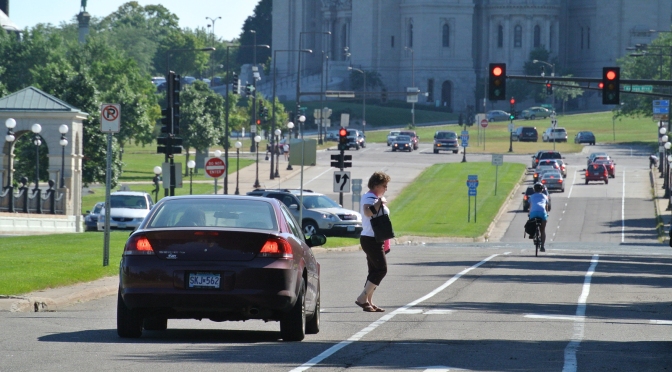Improving the rates of drivers yielding to pedestrians has been challenging despite crosswalk laws. Expanding on an earlier study, researchers further explored the effectiveness of engineering treatments at road crossings, giving agencies a deeper understanding of how to maximize pedestrian safety.
Continue reading Improving Driver Yielding to Pedestrians at IntersectionsCategory Archives: Pedestrian
Designing Pedestrian Safety Features for Year-Round Maintenance
Pedestrian safety countermeasures near roadways require year-round maintenance to be effective. Clearing snow and ice has not generally been a design consideration for safety treatments, but new research has identified specific design criteria to help MnDOT and other agencies keep walkways clear without impeding maintenance efforts.
Continue reading Designing Pedestrian Safety Features for Year-Round MaintenanceShort Films, Big Visions: Transportation-themed films spark conversation about community connections
April 4, 2023
Dozens of community members and transportation advocates tuned in to “Short Films, Big Visions: A Series on Transportation and Community” on February 23. Co-hosted by CTS and the Humphrey School of Public Affairs, the virtual event featured a screening of short films produced by the Redford Center for its “Community Power” series followed by an engaging panel discussion.
Continue reading Short Films, Big Visions: Transportation-themed films spark conversation about community connectionsHow Did COVID Impact Biking and Walking in Minnesota? Trail Data Holds Answers, Say U of M Researchers
This article was originally published in Catalyst, May 2022.
Photos and stories about people biking and walking on packed trails were common during the early stages of the COVID-19 pandemic. Transportation researchers also reported surges in bicycling and walking during this time of social restrictions and widespread closures, but little was known about how those surges related to longer-term trends.
Continue reading How Did COVID Impact Biking and Walking in Minnesota? Trail Data Holds Answers, Say U of M ResearchersNew Project: Designing and Implementing Maintainable Pedestrian Safety Countermeasures
In Minnesota, one challenge with installing safety countermeasures for people walking and ensuring year-round access to pedestrian infrastructure is winter maintenance.
Continue reading New Project: Designing and Implementing Maintainable Pedestrian Safety CountermeasuresNew Approach Helps Estimate COVID Exposure Risk for Trail Users
This article was originally published in Catalyst, November 2021.
As gyms and indoor health facilities closed during the beginning of the pandemic, people flocked to trails and parks, creating both opportunities and concerns for public health and land managers. The US Centers for Disease Control and Prevention (CDC) recommended a six-foot distance between people (even outdoors), but little was known about compliance with these recommendations.
Continue reading New Approach Helps Estimate COVID Exposure Risk for Trail UsersNew Project: Mobile-Device Data, Non-Motorized Traffic Monitoring, and Estimation of Annual Average Daily Bicyclist and Pedestrian Flows
Understanding pedestrian and bicyclist flows is vital to distributing a limited construction budget to new infrastructure for improved safety on specific roads. Unfortunately, statewide data collection for active transportation flows is challenging.
MnDOT and local agencies historically have lacked estimates of bicycle and pedestrian traffic on Trunk Highways and County State Aid Highways.
Since about 2016, MnDOT has begun monitoring bicycle and pedestrian flow at more than 25 locations across the state, but, given the small number of counters and the variability of flows in response to variations in weather across Minnesota, these monitoring data are insufficient for estimation of Annual Average Daily Bicyclists and Annual Average Daily Pedestrians.
One option for obtaining travel data without expensive infrastructure is relying on mobile data collection.
Continue reading New Project: Mobile-Device Data, Non-Motorized Traffic Monitoring, and Estimation of Annual Average Daily Bicyclist and Pedestrian FlowsTeam Receives NSF Grant to Study ‘Smart e-Scooters’
This article was originally published in Catalyst, November 2020.
Electric scooters let riders move quickly between the roadway and the sidewalk, but these sometimes-unpredictable travel patterns can pose risk for riders and the people around them. Making scooters smarter is the goal of a new U of M research project funded by the National Science Foundation (NSF). Under the $1.2 million Cyber-Physical Systems grant, a cross-disciplinary team will study smart tracking systems on scooters for ensuring safe and smooth interaction with other vehicles and pedestrians.
Continue reading Team Receives NSF Grant to Study ‘Smart e-Scooters’New Project: Pedestrian User Experience at Roundabouts
Roundabouts reduce the severity of crashes at intersections, but transportation agencies have received some feedback from pedestrians indicating that roundabouts, especially larger multi-lane roundabouts, can be difficult to navigate.
Continue reading New Project: Pedestrian User Experience at RoundaboutsSelecting Uncontrolled Pedestrian Crosswalk Treatments
A new guidebook published by the Minnesota Local Road Research Board offers a uniform approach and practical methods for selecting locations and the right treatment for uncontrolled pedestrian crosswalks in Minnesota.
Continue reading Selecting Uncontrolled Pedestrian Crosswalk Treatments










